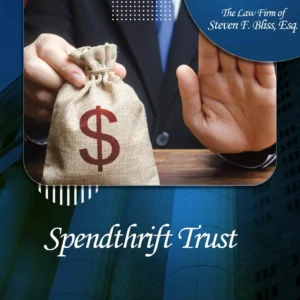A Spendthrift Trust Is A Type Of Trust That Enables Asset Protection.
Spendthrift Trust
Listen to this Article on:
The use of a spendthrift trusts to help protect assets.
Spendthrift Trust: A spendthrift trust is a trust designed so that the Beneficiary cannot sell or give away their equitable interest in the trust property. Moreover, the Trustee is in control of managing the property. Thus, the Beneficiary of the Trust does not have the property, and her creditors cannot reach those assets.

The most challenging part of creating an estate plan is not deciding whom to include as beneficiaries but how to gift assets to those beneficiaries. For example, you may be reluctant to pass down assets directly to a beneficiary because that individual cannot be trusted to manage their own money for one reason or another. If you find yourself in that position, a spendthrift trust may be the solution; let’s see how a spendthrift trust works.
How Does a Spendthrift Trust Work?
While you have complete control and access to all your Trust assets during your life, your beneficiaries do not have such access and control over their inheritance on your death. Placing spendthrift and asset protection provisions in your Trust protects your Beneficiaries from themselves by shielding their legacy from your Beneficiaries’ creditors. Consequently, such Trusts can be set up for the lifetime benefit of the Beneficiary and, upon the Beneficiary’s death, can be set to distribute to others.
The Trustee exercises complete discretion regarding when, how, and how much the Beneficiary is to receive. If you are interested in protecting your Beneficiaries or would like to learn more about spendthrift Trusts, we encourage you to reach out to our firm.
Please Help Us Spread The Word By Giving Us a 5 Star Rating on This Article
Free Initial Consultation with
Steven F. Bliss Esq.

★ ★ ★ ★ ★

The Spendthrift Beneficiary
Do you have an adult child, or other Beneficiary, who qualifies as a spendthrift? This is someone who never seems to be able to handle money and spends way more money than they should. Most families have one. Accordingly, sometimes the lack of financial acumen has an actual cause, such as addiction or mental illness. There is no apparent reason they don’t handle money well; however, it is universally agreed that money management is not their strong suit. Understandably, handing a spendthrift beneficiary a sizeable inheritance likely makes you nervous. Fortunately, there is an estate planning tool that can help.
Benefits of the Spendthrift Trust?
One of the many benefits of using a trust instead of a Will to distribute an inheritance is retaining a certain amount of control over how that inheritance is used. A spendthrift trust is a specialized type of Trust aimed at preventing the beneficiaries of the Trust from squandering their inheritance. Precise language must be used to create a spendthrift clause; however, when drafted properly, a spendthrift clause will prevent a beneficiary from spending the trust funds frivolously and avoid borrowing against those funds encumbering the funds in any way. A spendthrift clause can also prevent the Beneficiary’s creditors from accessing the trust funds to pay the Beneficiary’s debts. Nevertheless, a spendthrift trust wraps the trust assets in a layer of protection against outside claims to the assets and against the Beneficiary’s inability to handle money.
California Law and Spendthrift Provisions
Because state laws govern most aspects of trust creation and trust administration, we must look to California law to determine if a spendthrift provision within a trust agreement is enforceable. In 2017, the California Supreme Court handed down a ruling that significantly weakened the protection offered by a spendthrift provision within a trust. Before the holding in Carmack v. Reynolds, the law essentially protected assets held by a trust until those assets were distributed to the Beneficiary. Moreover, the law now allows creditors to reach undistributed assets. Specifically, the court said, “With limited exceptions for distributions explicitly intended or required for the beneficiary’s support, a general creditor may reach a sum, up to the full amount of any distributions that are currently due and payable to the beneficiary even though they are still in the trustee’s hands, and separately may reach up to 25 percent of any payments that are anticipated to be made to the beneficiary.”
Consequently, the new ruling takes much of the protection afforded by a spendthrift trust away; the ruling did not do away with the “beneficiary support” exception. The beneficiary support exception continues to protect assets designated for the Beneficiary’s support. Therefore, a carefully worded spendthrift provision in a trust agreement may still be able to shelter and protect assets. This can be a handy tool for people who do not wish to disinherit certain heirs and want to make sure that such inheritance is not squandered.
However, it is essential to note that once the Trustee has distributed assets or funds to the Beneficiary, they are no longer protected from the Beneficiary’s creditors; only assets/funds held within the Trust are protected.
